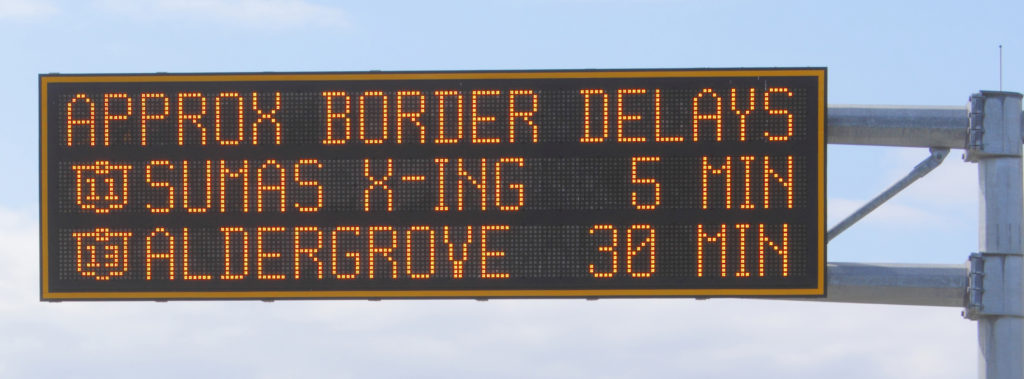2023 Cascade Gateway Advanced Border Information System – Planning Phase
Status: Starting — ITS Project
This project will evaluate technologies to replace and improve aging wait time systems at the Cascade Gateway system of border crossings between the Lower Mainland of British Columbia and Whatcom County, Washington State.
Location
Cascade Gateway system of border crossings (Peace Arch/Douglas, Pacific Highway, Lynden/Aldergrove, and Sumas/Abbotsford-Huntingdon Ports-of-Entry) and their approach roads
Why This Project Was Needed
Existing border traveler information systems are in place at the four Cascade Gateway land ports-of-entry. The systems are operated by WA State Department of Transportation (WSDOT) northbound and the B.C. Ministry of Transportation and Infrastructure (BCMOTI) southbound. These systems are designed to optimize traffic flow across the ports and inform travelers of relative travel times at each crossing. Since 2007, both systems have exported their data to an online binational archive at www.borderdata.org.
Both WSDOT and BCMOTI systems are 20 years old, and the hardware and back-end systems are failing and/or becoming obsolete. The existing systems have faced numerous challenges:
- The technology used to estimate traffic delay (loop detectors) doesn’t work as well in queued conditions like those found at a border crossing.
- The fixed locations of loop detectors have made it difficult to keep wait time systems accurate alongside infrastructure improvements at the border, including realigned and lengthened lanes, new port facilities, and operational changes.
- The current loop detector system estimates current wait time – the wait likely to be experienced by the next arriving vehicle. Other technologies (e.g., Bluetooth) estimate actual wait time – the wait that the last vehicle departing an inspection booth actually experienced. Actual wait times are the more appropriate system performance metric.
- Northbound and southbound systems are impacted by inspection agencies changing the functions of any booth; if personal vehicles (cars) are diverted to the commercial (heavy truck) booths, for example, the system will not record them as cars or add them to the calculation.
- Current field systems are not as effective as newer technologies. The servers and the cabinets are obsolete, the algorithms used for data processing were developed 20 years ago, and some communications use less-reliable wireless transmission.
- The Greening the Border Initiative of 2008 encourages anti-idling systems. A southbound anti-idling system has been operating since 2010 and encourages travelers to shut off their engines while waiting at the border. A northbound system at the same crossing would have multiple benefits.
- The existing system does not include wait times for commercial vehicles. But a commercial vehicle wait time system would allow trucks to evaluate whether an alternate cross-border route would be faster.
Results
This Stage I grant will identify technology options, coordinate stakeholder participation, and develop an installation plan for the ABIS. The scope of work for this planning phase project includes the following:
- Evaluate advanced technologies for cross-border wait time measurements
- Evaluate partnership agreements needed to complete the project
- Work with archive maintenance team to develop options for archiving the data
- Confirm the proposed solution will integrate with existing traveler information and inspection agency systems
- Complete an installation plan that includes an assessment of cost savings and performance improvements
The Stage I planning phase project should answer these questions:
- What technology(ies) can accurately estimate wait times for the different modes and lane types in an area with mixed wireless data coverage?
- What are the costs of these technologies? What are the maintenance costs?
- Has a system like this been deployed in a heavily queued traffic area like a border crossing?
- How will the system integrate with existing traveler information systems and data archives?
Cost
In March 2023, the Whatcom Council of Governments was awarded $458,000 from the SMART Grants Program.
Funding & Partnerships
The project will be undertaken along with regional stakeholder agencies, including B.C. Ministry of Transportation, WA State Department of Transportation, U.S. Customs & Border Protection, and Canada Border Services Agency.

